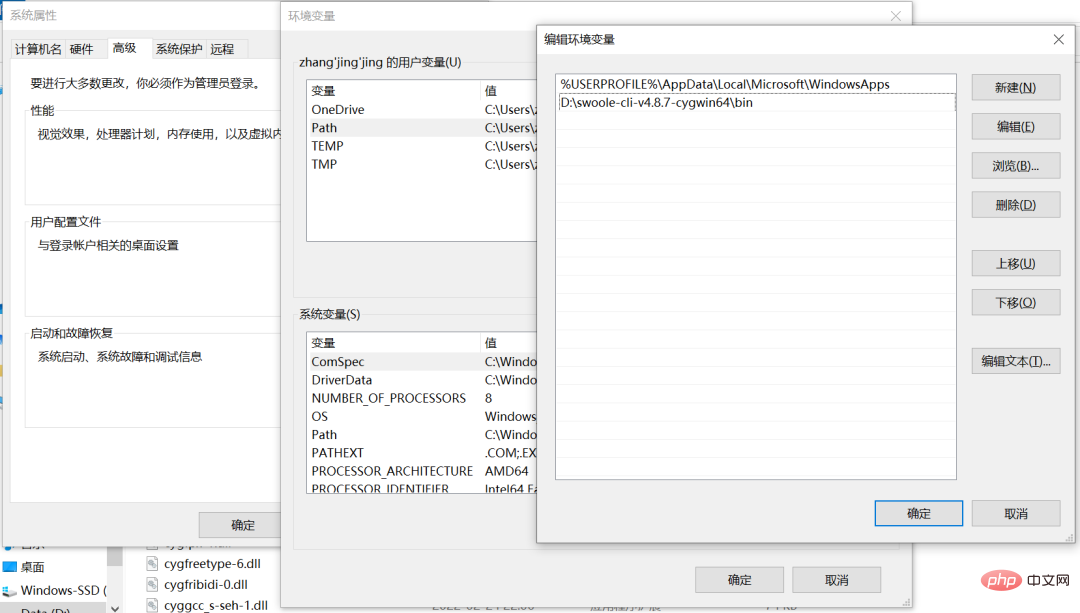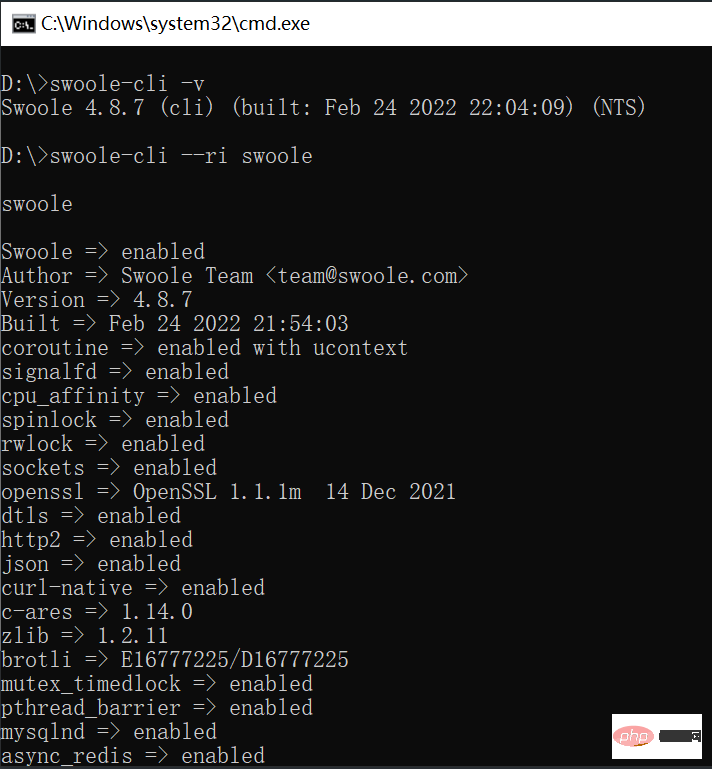The latest swoole-cli can support Windows environment!
This article brings you the relevant implementation steps for swoole-cli to support the Windows environment. The latest swoole-cli supports the Windows environment and is based on cygwin64. You can download it and use it. I hope it will be helpful to everyone.

Recommended learning: swoole video tutorial
The latest swoole-cli supports Windows environment and is implemented based on cygwin64. Download and use.
Download
A newly installed Windows machine (must be a 64-bit system) does not need to install any php related Software package, you can directly download the executable program zip compressed package of swoole-cli-cygwin64, and then unzip it to any directory.
swoole-cli is installation-free and can be used directly
Download address: https://github.com/swoole/swoole-src/releases /download/v4.8.7/swoole-cli-v4.8.7-cygwin64.zip
swoole-cli will be released simultaneously with swoole. You can download the latest version of swoole from the github release page -cli

To use
, you first need to configure the decompressed folder/bin directory into the system's Path environment variable.


Use win r to enter cmd to enter the Windows command line. You can use the swoole-cli command to execute the swoole or php program.

Extensions
swoole-cli contains various commonly used extensions, the list is as follows:
If you want to add extensions To swoole-cli, you can submit an issue on the official github homepage of swoole
The PHP version used by swoole-cli is 8.1.1
D:\>swoole-cli -m [PHP Modules] bcmath bz2 Core ctype curl date dom exif fileinfo filter gd gmp hash iconv imagick json libxml mbstring mysqli mysqlnd openssl pcre PDO pdo_mysql pdo_sqlite Phar posix redis Reflection session SimpleXML soap sockets sodium SPL sqlite3 standard swoole tokenizer xml xmlreader xmlwriter xsl yaml zip zlib [Zend Modules]
Start the Web server
Write the simplest Web service for testing. The file name is server.php:
<?php
$http = new Swoole\Http\Server('127.0.0.1', 9501, SWOOLE_BASE);
$http->on('start', function ($server) {
echo "Swoole http server is started at http://127.0.0.1:9501\n";
});
$http->on('request', function ($request, $response) {
$response->header('Content-Type', 'text/plain');
$response->end('Hello World');
});
$http->start();Run:

Open the browser and enter http:// You can see the results at 127.0.0.1:9501/.

Recommended learning: swoole tutorial
The above is the detailed content of The latest swoole-cli can support Windows environment!. For more information, please follow other related articles on the PHP Chinese website!

Hot AI Tools

Undresser.AI Undress
AI-powered app for creating realistic nude photos

AI Clothes Remover
Online AI tool for removing clothes from photos.

Undress AI Tool
Undress images for free

Clothoff.io
AI clothes remover

Video Face Swap
Swap faces in any video effortlessly with our completely free AI face swap tool!

Hot Article

Hot Tools

Notepad++7.3.1
Easy-to-use and free code editor

SublimeText3 Chinese version
Chinese version, very easy to use

Zend Studio 13.0.1
Powerful PHP integrated development environment

Dreamweaver CS6
Visual web development tools

SublimeText3 Mac version
God-level code editing software (SublimeText3)

Hot Topics
 1387
1387
 52
52
 How to use swoole coroutine in laravel
Apr 09, 2024 pm 06:48 PM
How to use swoole coroutine in laravel
Apr 09, 2024 pm 06:48 PM
Using Swoole coroutines in Laravel can process a large number of requests concurrently. The advantages include: Concurrent processing: allows multiple requests to be processed at the same time. High performance: Based on the Linux epoll event mechanism, it processes requests efficiently. Low resource consumption: requires fewer server resources. Easy to integrate: Seamless integration with Laravel framework, simple to use.
 How to use Swoole to implement a high-performance HTTP reverse proxy server
Nov 07, 2023 am 08:18 AM
How to use Swoole to implement a high-performance HTTP reverse proxy server
Nov 07, 2023 am 08:18 AM
How to use Swoole to implement a high-performance HTTP reverse proxy server Swoole is a high-performance, asynchronous, and concurrent network communication framework based on the PHP language. It provides a series of network functions and can be used to implement HTTP servers, WebSocket servers, etc. In this article, we will introduce how to use Swoole to implement a high-performance HTTP reverse proxy server and provide specific code examples. Environment configuration First, we need to install the Swoole extension on the server
 How does swoole_process allow users to switch?
Apr 09, 2024 pm 06:21 PM
How does swoole_process allow users to switch?
Apr 09, 2024 pm 06:21 PM
Swoole Process allows users to switch. The specific steps are: create a process; set the process user; start the process.
 Which one is better, swoole or workerman?
Apr 09, 2024 pm 07:00 PM
Which one is better, swoole or workerman?
Apr 09, 2024 pm 07:00 PM
Swoole and Workerman are both high-performance PHP server frameworks. Known for its asynchronous processing, excellent performance, and scalability, Swoole is suitable for projects that need to handle a large number of concurrent requests and high throughput. Workerman offers the flexibility of both asynchronous and synchronous modes, with an intuitive API that is better suited for ease of use and projects that handle lower concurrency volumes.
 How to restart the service in swoole framework
Apr 09, 2024 pm 06:15 PM
How to restart the service in swoole framework
Apr 09, 2024 pm 06:15 PM
To restart the Swoole service, follow these steps: Check the service status and get the PID. Use "kill -15 PID" to stop the service. Restart the service using the same command that was used to start the service.
 Which one has better performance, swoole or java?
Apr 09, 2024 pm 07:03 PM
Which one has better performance, swoole or java?
Apr 09, 2024 pm 07:03 PM
Performance comparison: Throughput: Swoole has higher throughput thanks to its coroutine mechanism. Latency: Swoole's coroutine context switching has lower overhead and smaller latency. Memory consumption: Swoole's coroutines occupy less memory. Ease of use: Swoole provides an easier-to-use concurrent programming API.
 Swoole in action: How to use coroutines for concurrent task processing
Nov 07, 2023 pm 02:55 PM
Swoole in action: How to use coroutines for concurrent task processing
Nov 07, 2023 pm 02:55 PM
Swoole in action: How to use coroutines for concurrent task processing Introduction In daily development, we often encounter situations where we need to handle multiple tasks at the same time. The traditional processing method is to use multi-threads or multi-processes to achieve concurrent processing, but this method has certain problems in performance and resource consumption. As a scripting language, PHP usually cannot directly use multi-threading or multi-process methods to handle tasks. However, with the help of the Swoole coroutine library, we can use coroutines to achieve high-performance concurrent task processing. This article will introduce
 How is the swoole coroutine scheduled?
Apr 09, 2024 pm 07:06 PM
How is the swoole coroutine scheduled?
Apr 09, 2024 pm 07:06 PM
Swoole coroutine is a lightweight concurrency library that allows developers to write concurrent programs. The Swoole coroutine scheduling mechanism is based on the coroutine mode and event loop, using the coroutine stack to manage coroutine execution, and suspend them after the coroutine gives up control. The event loop handles IO and timer events. When the coroutine gives up control, it is suspended and returns to the event loop. When an event occurs, Swoole switches from the event loop to the pending coroutine, completing the switch by saving and loading the coroutine state. Coroutine scheduling uses a priority mechanism and supports suspend, sleep, and resume operations to flexibly control coroutine execution.




